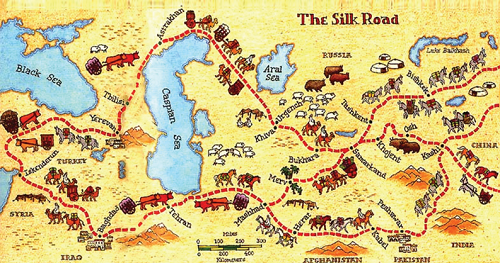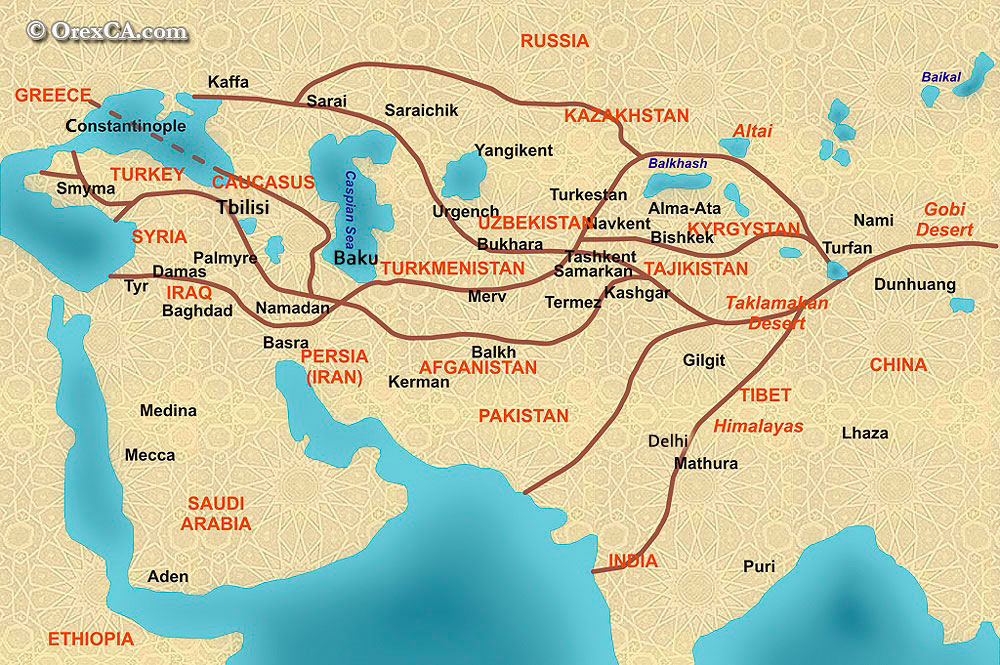Historic
and New Silk Road and perspectives for European Integration of Georgia
By: Nika Chitadze
Director
of the Center for International Studies
Professor
of the International Black Sea University
President
of the George C. Marshall Center Alumni Union, Georgia – International and
Security Research Center

Introduction
Georgia
is a small country on the crossroads of Europe and Asia. At the same time, together
with the economic benefits for the country, which had and has its important
geopolitical place between different civilizations, there were frequent
confrontations for the gaining control over Georgia and Caucasus Region due to
the fact, that modern territory of Georgia was located on one of the branch of
the Great Silk Road. Historic Silk Road was functioning since 8-7-th Centuries
B.C. till the middle of 15-th Century. After the collapse of Constantinople in
1453, the interregional Silk Road lost its function, and Georgia was in a very
difficult situation, that spanned centuries. By the end of the 20th century,
after the end of the Cold War, the issue of the Silk Road acquired a special
significance, especially after approval by European Union TRACECA (Euro-Asia
Transport Corridor) project in 1993 and after the Chinese President's Xi
Jinping initiative for the granting the new life to the historic Silk Road
within the project - "One Girdle One Way" in 2013.


Historical aspects of the
development the great silk road
The Silk Road can be considered
to be a clear
symbol of the links between the East and the West, which has become a natural
extension of the spiritual, cultural and trade relations of millennia between
these civilizations.
The development of trade turnover has led to the intensification of
migration flows, reflected in artistic monuments, migratory flows led to the
global change of the Eurasian ethnic map.
The
transcontinental transit of the famous "Silk Great Trading Road"
started in Sinzhiyan (China), and then part of the city of Kashgar to the south
of the Mediterranean Sea, and the second to the Caspian Sea and then to the
South Caucasus countries (Albania, Iberia, Colchis) Mtkvari River and Rioni
rivers –was reaching to the Black Sea port city of phases, which were available
to transport the goods by the sea to Europe. Via these ways, the first Chinese
silk got the Europe (in the second century B.C.) and from that time this route was
called "the Silk Great Trade Road."
Furthermore,
for the determination the strong connection of Georgian kindgoms with the
outside world, it should be mentioned as a great significance the discovery of
bacterial silver coins in the territory of Iberia (today's East Georgia) in
Tbilisi and Aragvi Gorge (Pasanauri).
The
World famous Greek geographer Strabo (64-63 - newly 23-24) in his book
"Geography" states, that one transport way from Europe to Asia
included the route from Black Sea costs to the river Phasisi (Rioni). Scientists
went to Iberia and visited its capital Mtskheta. According to Strabo, across the
river at the time about 120 bridges were located.
There
was another historic road that came from the Caucasus Albania (today's
Azerbaijan and the surrounding area), into the Caucasus Iberia. This path was
still in the rock, and then, according to Strabo, was a swamp that created the
Alazane River (modern Alazani)
According
to Strabo, there was a third way, from Armenia to the Caucasus Iberia. The road
was crossing the banks of the river Mtkvari. There was a
fourth way. According to Strabo and other authors, this route passed through
the Tergi Gorge and the Aragvi River to the other side of the Aragvi River,
from the Dariali Alan gate to the capital of Iberia Mtskheta. These four
historic roads were connecting in Mtskheta, the capital of Kartli (Caucasus
Iberia). One of the most interesting ways on the interregional level covered
the territories between Iberia and Kolkheti from one side, and India and China
from another side. It was a great international trade route.
As it was mentioned, This path has existed before the collapse of
Constantinople. After 1453, economic and cultural ties between the countries
fell apart. Georgia has been in a deadlock and Europe has
lost interest in the road before the
period of the disintegration of the Soviet Empire.
Prospects of restoration of Silk Road
after the Cold War
After the restoration of the national independence in
the beginning of 90-th of the XX Century, Georgia gained an opportunity to be
integrated to the international society.
In
the contemporary period, together with other parameters, the importance of the Georgia's
geopolitical location can be determined by its involvement to the transport and
energy projects. It’s territory is an axis of Europe - Caucasus - Asia
transport corridor system. It also constitutes energy corridor, as well it is
the shortest transit line which connects with each other the countries of Europe
and Asia. Thus, Georgia can contribute to the functioning of New "Great
Silk Road".
For
example, by the involvement in the Transport and energy projects - Georgia is able
to contribute in the transportation of the energy resources from the Caspian
Sea and Central Asian regions via alternative routes. Georgia’s Black Sea ports
(turnover of goods of Poti port is between 6-8 million tones per year, and
future capacity of Anaklia port will be about seven million tones), the
Baku-Supsa (capacity five million tones of oil) and Baku-Tbilisi-Ceyhan (capacity
50 million tones) oil pipelines, Baku-Tbilisi-Erzurum gas pipeline (capacity 8
billion cubic meters) and future gas pipeline project TANAP (Trans Anatolian
Project with capacity from 16-32 Billion cubic meters of natural gas) represent
the clear examples of the transit role of the country.
Together
with above – mentioned transport and energy projects, Georgia is an active
participant in such important transport project – as the Baku-Tbilisi-Kars
railway. The initiative is intended to establish a transport corridor
linking Azerbaijan to Turkey through the territory of Georgia by rail. At the
same time, the next step is to connect China with Central Asia, Caucasus, and
Europe via railway system - For example, in late 2015, the train took only 15
days to travel from South Korea to Istanbul through China. It is much more
shorter period, than the transportation of goods by ship. The railway line is
intended to provide transportation an initial annual volume of 6.5 million
tones with the long-term perspectives to increase the volume of goods up
to 17 million tones.
Taking into
consideration the above-mentioned realities, by the initiative of China, in
2014 The Silk Road
Fund was created. Chinese
initiative was interrelated to promote project "one belt, one
road". The foundation's capital was $ 40 billion.


EU Strategy toward the transport and energy
projects and role of Georgia
As it was mentioned
above, after the disintegration of USSR, world democratic community expressed
its interest toward the post-soviet space, particularly toward the Caucasus
Region. In this regard, for the implementation of the programs in the field of transport
and energy, the TRACECA (Europe-Caucasus-Asia Transport Corridor) project has
been approved. In the framework of this project, the First conference was held
in Brussels in May 1993, with the participation of the EU (European Commission),
Central Asian (Kazakhstan, Uzbekistan, Turkmenistan, Tajikistan, Kyrgyzstan)
and South Caucasus (Georgia, Azerbaijan and Armenia) states delegations.
There are five working
groups in the framework of the TRACECA: Maritime Transport, Aviation Road and
Rail, Transport safety and transport infrastructure.
Taking
into account the importance of this project, In the framework of Eastern
Partnership Program, in the beginning of 2019, European Union has released
€12.845 Billion Euro, from where Georgia will receive €3.417 Billion. Among of
this amount, the biggest part, €1 billion will come on the reconstruction of
the central road of Georgia. For the Anaklia sea port about €333 million will be allocated. From this amount, about €100 million will
cover the expenses for the road and railway construction from the different regions
of Georgia till this Black Sea Port.
For
the simplification the transportation of goods, it is planned to construct 96
bridges and 53 tunnels, which will shorten the time for transportation through
the territory of Georgia for tracks and passengers for 40 minutes.
From Poti port till the state border between Turkey and Georgia, the reconstruction of the road will be funded by €241 million.
From Poti port till the state border between Turkey and Georgia, the reconstruction of the road will be funded by €241 million.
Other
important transport and communication system project is reconstruction of road
from Georgian city Rustavi till Red bridge – State border between Azerbaijan
and Georgia. For this project about 155 million Euro will be spent. In general,
for the 10 road project with the whole length 280 km. €2.087 billion will be
spent and on the 2 railway project with the length 90 km, €349 million will be
released.

Conclusion
In
general, in the framework of Eastern Partnerhip Prgram, the biggest part of the funding
€4.453 Billion will be released for Ukraine. The
smaller part, €732 million
for Armenia.
At the same time, By EU financial aid, Georgia is a leader within this program by per capita with €916, which prevails for 3,55
times the amount of funds for Moldova, which is at the second
place by per capita.
In
general, transport and energy Projects in the framework of Great Silk Road will
promote the further integration of Georgia to the European and Euro-Atlantic
structures. In case of the projects realization, International community will be
more interested in the stability of Georgia as a transit country.
Comments
Post a Comment